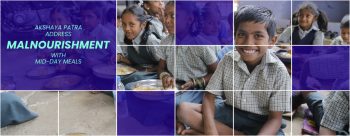Why is the thought that ‘we serve food for education’ upheld with great pride by Akshaya Patra, and even the government backing the idea by implementing mid-day meals scheme in schools?
Yes it is as simple, because you can reach out to more children in a more organised way. Government schools in particular become the obvious target, as more children from a disadvantaged economic background attend government schools. Yet, there are reasons beyond this.
Even though one can reach out to more children at schools, the strategic aim is to reach much more by incentivising food, for attending school throughout the year. In many ways an incentive that is food, brings and retains children in school which ensures them education at the same time. Let’s throw some light on how food acts as an incentive:
- Firstly, many children do not attend school because of poverty. Children are engaged as child labourers where many a time they are working for earning just one square meal of the day. Feeding in school not only gives them access to food but also ensures that they receive education, making two hits with one stone
- Once children realise that they will get one full meal that is tasty and fresh, they tend to attend school regularly, which results in a reduced dropout rate and better attendance
- Many regions have shown increased enrolment of girl children, as parents who don’t find it important to educate a girl child would still send their daughter to school since she has access to nutritious food, which is considered more essential by the parents. This way the girl child also gets an opportunity to attend school and to access education.
 In a country like India where poverty is immense and the extent of hunger and malnutrition is afflicting, an initiative such as ‘food for education’ addresses a larger issue. By effective implementation of the Mid-Day Meal, children not only have access to food and education but also get an opportunity to lead a better life. Children are the future of the nation. Through the initiative of food for education, they could survive with better health while improving their employability quotient as they acquire better skills. This ensures them better income and standard of living as opposed to no education and poor health due to lack of nutrition.
In a country like India where poverty is immense and the extent of hunger and malnutrition is afflicting, an initiative such as ‘food for education’ addresses a larger issue. By effective implementation of the Mid-Day Meal, children not only have access to food and education but also get an opportunity to lead a better life. Children are the future of the nation. Through the initiative of food for education, they could survive with better health while improving their employability quotient as they acquire better skills. This ensures them better income and standard of living as opposed to no education and poor health due to lack of nutrition.
If generations of children are given such an opportunity year after year, at some point in the future this effort could lead to the alleviation of poverty. Mid-Day Meal scheme is a multi-faceted approach to provide opportunities to the children of today for a better tomorrow. One meal at a time, Akshaya Patra hopes to change the lives of underserved children; aiding in realisation of their basic rights such as Right To Food and Right To Education. For many such reasons, Akshaya Patra mid-day meal has come to be known as Food for Education, and the organisation is driven by the impact the food for education has had over years.








good blog…